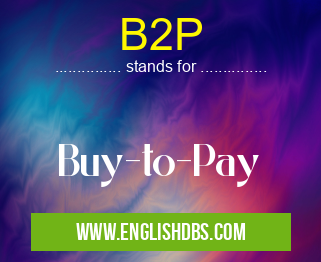What does B2P mean in MISCELLANEOUS
B2P (Buy-to-Pay) is a comprehensive term that encompasses the complete cycle of business processes involved in procuring goods or services from suppliers, to receiving and paying for them. It plays a crucial role in streamlining supply chain management and optimizing operational efficiency.

B2P meaning in Miscellaneous in Miscellaneous
B2P mostly used in an acronym Miscellaneous in Category Miscellaneous that means Buy-to-Pay
Shorthand: B2P,
Full Form: Buy-to-Pay
For more information of "Buy-to-Pay", see the section below.
B2P Process
The B2P process typically involves the following steps:
- Purchase Requisition: Initiating the need for a purchase.
- Purchase Order: Placing a formal order with the supplier.
- Receipt of Goods or Services: Receiving and inspecting the delivered items.
- Invoice Processing: Verifying and approving for payment.
- Payment: Settling the outstanding invoice.
Benefits of B2P Automation
Automating the B2P process offers significant benefits, including:
- Reduced Costs: Streamlining processes and eliminating manual tasks.
- Increased Efficiency: Automating repetitive tasks, freeing up resources for higher-value activities.
- Improved Accuracy: Minimizing errors and ensuring consistent data management.
- Enhanced Visibility: Providing real-time insights into the entire procurement process.
- Supplier Collaboration: Streamlining communication and collaboration with suppliers.
Essential Questions and Answers on Buy-to-Pay in "MISCELLANEOUS»MISCELLANEOUS"
What is Buy-to-Pay (B2P)?
Buy-to-Pay (B2P) is a business process that automates the procurement cycle from the point of purchase to payment. It streamlines and consolidates the entire purchasing process, reducing costs, improving efficiency, and enhancing visibility and control.
How does B2P work?
B2P typically involves several key steps, including:
- Creating purchase requisitions
- Sourcing and selecting suppliers
- Issuing purchase orders
- Receiving goods or services
- Invoice processing and payment
- Supplier performance management
B2P systems integrate these steps, automating tasks and providing real-time visibility into the procurement process.
What are the benefits of implementing a B2P system?
Implementing a B2P system offers numerous benefits, including:
- Reduced costs through process automation and improved supplier negotiations
- Enhanced efficiency through streamlined workflows and elimination of manual tasks
- Increased visibility and control over the procurement process
- Improved supplier performance through collaboration and performance monitoring
- Enhanced compliance with procurement regulations and policies
What are the key features of a B2P system?
Key features of a B2P system typically include:
- Purchase requisition management
- Supplier management and sourcing
- Purchase order processing
- Invoice processing and payment
- Inventory management
- Reporting and analytics
What is the difference between B2P and P2P (Procure-to-Pay)?
B2P and P2P are often used interchangeably, but there is a slight distinction. B2P focuses on the procurement cycle from purchasing to payment, while P2P encompasses the entire purchase-to-pay cycle, including post-payment activities such as expense management, accounts payable, and supplier performance management.
Final Words: B2P is a vital aspect of business operations, encompassing the entire process from purchase requisition to payment. By automating B2P processes, businesses can optimize supply chain efficiency, reduce costs, and enhance operational visibility. As businesses continue to strive for competitiveness, leveraging B2P automation will become increasingly crucial to achieving success in the modern digital landscape.
